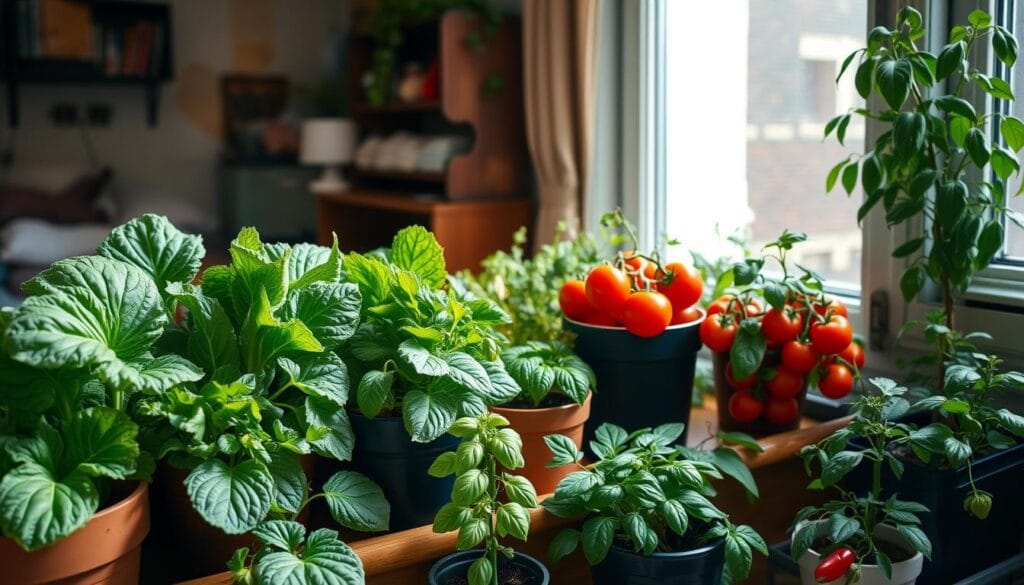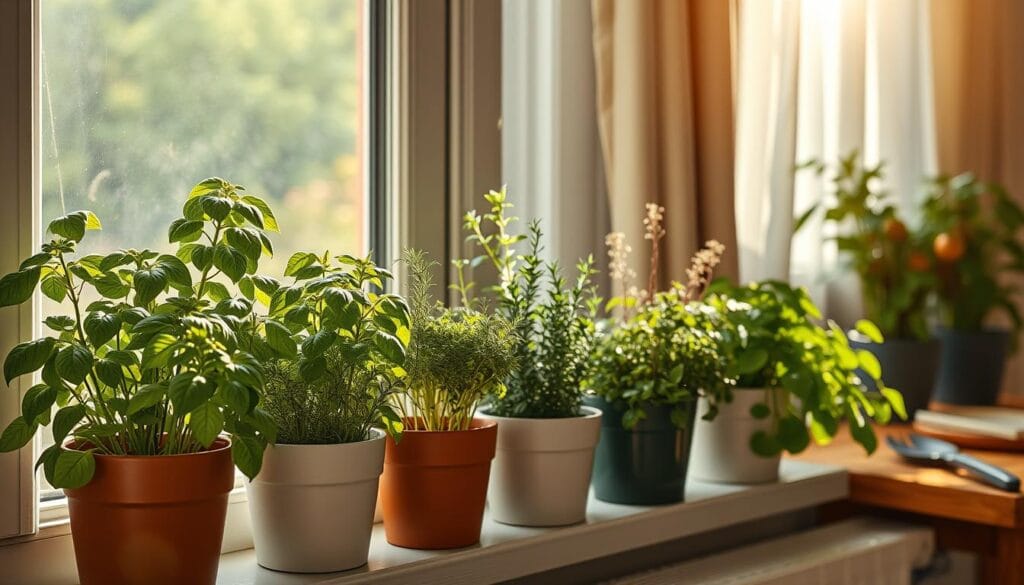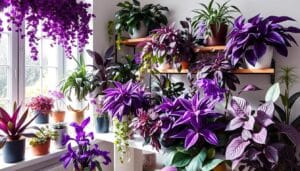Table of Contents
Urban gardening is getting more popular as people embrace sustainable living. You can grow fresh veggies indoors, even with little space. This guide will show you how to turn your home into a green space. We’ll share key tips for growing plants in containers, helping you get a lot of food and live healthier.

Understanding Indoor Apartment Vegetable Gardening
Indoor apartment vegetable gardening comes with its own set of challenges and opportunities. Many city folks face the issue of limited space, making small space gardening a must. Learning how to care for indoor vegetable plants in these tight spots is key to success.
Light is crucial for plant growth. In apartments, natural light can be hard to find, especially in rooms facing north. To solve this, using grow lights is a good idea. These lights give plants the spectrum they need for photosynthesis and can be adjusted for each plant’s needs.
Keeping the right temperature and humidity is also vital. Most indoor plants do best in temperatures between 65°F and 75°F. Keeping the humidity right helps avoid pests and diseases. A small humidifier can make a big difference in creating the perfect environment.
Good air circulation is important for plant health. It helps prevent mold and mildew. By regularly rotating your pots and using fans, you can improve air flow around your plants. These tips are essential for making your indoor garden thrive, even in tough conditions.
Choosing the Right Indoor Vegetable Plants
Choosing the right indoor vegetable plants is key to a successful indoor garden. It’s important to pick plants that grow well in small spaces. This is especially true for those living in apartments.
Best Vegetables for Indoor Growing
Here are some top picks for indoor growing. They offer great taste and are easy to care for:
- Lettuce: Grows quickly and can be harvested multiple times.
- Radishes: Fast-growing with a short harvest time, perfect for immediate results.
- Cherry Tomatoes: Compact varieties thrive in pots, providing a rewarding yield.
- Green Onions: Easy to regrow from leftovers and continual harvests available.
- Herbs: While technically not vegetables, they pair well in dishes and require minimal effort.
Fast-Growing Options for Beginners
For beginners, fast-growing options are great. They offer quick results and boost confidence:
- Spinach: Germinates rapidly and harvests in a matter of weeks.
- Arugula: Grows swiftly and adds a zesty flavor to salads.
- Beans: Quick to sprout and can be supported vertically to save space.

Essential Supplies for Container Gardening
Successful container gardening starts with the right supplies. You need the best containers, soil, and fertilizers. Also, knowing how to care for your plants is key.
Optimal Containers for Indoor Plants
Choosing the right container is crucial. Here are some important factors:
- Size: Make sure your container is big enough for your plants’ roots.
- Material: Clay pots are good for aeration, while plastic ones are light and keep moisture.
- Drainage: Containers with holes are best to avoid water buildup and root rot.
Soil and Fertilizers: What You Need to Know
The right soil and fertilizers are vital for healthy plants. Here are some tips:
- Potting Mix: Use a mix made for container gardening that drains well.
- Organic vs. Synthetic: Organic fertilizers are natural, while synthetic ones give quick nutrients.
- Balanced Nutrients: Pick fertilizers with balanced nitrogen, phosphorus, and potassium.

By focusing on these supplies, you’ll create a great space for your plants. This will make your container gardening fun and rewarding.
Lighting Solutions for Small Space Gardening
Lighting is key for indoor gardening in small spaces. Without enough light, plants can’t grow well. Knowing the difference between natural and grow lights helps gardeners choose the best option.
Natural Light vs. Grow Lights
Natural light from windows is the top choice for indoor gardening. But, many apartments don’t get enough sunlight, especially in winter. Grow lights offer a strong alternative, giving plants the light they need for photosynthesis.
- Natural Light: Best when available, but can be inconsistent.
- Grow Lights: Provide consistent coverage; can be tailored for various plants.
Placement Tips for Maximum Sun Exposure
To get the most sunlight indoors, follow these tips:
- Put plants near south-facing windows for the most light.
- Rotate pots weekly to ensure all sides get equal sun.
- Use reflective surfaces, like mirrors or white walls, to increase light levels.
Good lighting makes indoor gardening in small spaces better. By picking the right lights and placing plants well, you’ll create a great growing space.

| Lighting Type | Pros | Cons |
|---|---|---|
| Natural Light | Cost-effective, improves mood | Inconsistent, limited by seasons |
| Grow Lights | Consistent, adjustable, supports various growth stages | Higher energy cost, initial investment needed |
Indoor Herb Garden: Perfect for Apartments
Creating an indoor herb garden is a great way for those with small spaces to grow their own herbs. Even in tight spots, you can grow herbs that make your food taste better. An indoor herb garden brings freshness and color to your home. Let’s look at the best herbs for indoor gardens and how to care for them.
Top Herbs for Indoor Gardening
- Basil: A favorite for pasta and salads, basil loves warm spots.
- Mint: Its refreshing taste is great in drinks and food.
- Parsley: Full of vitamins, parsley adds flavor to many dishes.
- Chives: With a mild onion taste, chives are perfect for toppings and cooked dishes.
- Thyme: This herb is amazing in meats and stews, adding a lovely aroma.
Caring for Your Herb Plants
Keeping your indoor herb garden healthy is key. Here are some tips for apartment gardening:
- Watering: Keep the soil moist but not too wet. Water when the top inch feels dry.
- Light: Herbs need lots of natural light. If it’s hard to get sunlight, use grow lights.
- Harvesting: Trim leaves often to encourage new growth. Always use clean scissors to avoid harming the plant.
- Fertilizing: Feed your herbs with a balanced fertilizer every few weeks to keep them healthy.

Watering Techniques for Urban Gardening
Knowing how to water is key for growing veggies indoors. Right watering keeps plants healthy and prevents problems like root rot. Good strategies help your urban garden grow well.
How to Avoid Overwatering
Overwatering is a big issue in indoor gardens. Here are some tips to avoid it:
- Always check the soil moisture before watering. Insert your finger an inch deep; if it feels moist, hold off on watering.
- Use pots with drainage holes. This lets excess water out, keeping the soil dry.
- Change how often you water with the seasons. Plants need less water when it’s cooler.
- Water in the early morning or late afternoon. This cuts down on evaporation and helps plants absorb water better.
Signs Your Plants Need Water
Knowing when to water is crucial for keeping plants strong. Watch for these signs:
- Leaves look droopy or wilted, which means they’re thirsty.
- Soil pulls away from the pot edges, showing it’s dry.
- Leaves get crispy or brown at the tips, a sign of dehydration.
- Yellow leaves mean your plants need more water.

By learning these watering tips, indoor gardeners can grow healthy plants. They avoid common mistakes in urban gardening.
Indoor Apartment Vegetable Gardening: Best Practices
Successful indoor apartment vegetable gardening needs key best practices. Keeping the right humidity is vital. It helps prevent pests and diseases, making plants thrive. You can mist your plants or use a humidifier to keep the air moist.
Crop rotation is also crucial in urban gardening. Moving your plants around helps the soil stay rich. It also stops pests from building up, keeping your plants healthy.
Companion planting makes gardening better. Some plants help each other by fighting pests or improving taste. For instance, basil with tomatoes tastes better and keeps pests away.
Always keep learning and trying new things in your garden. Mix up your plants, try new seeds, and change how you care for them. Every little test can make your garden better.
- Maintain proper humidity levels for healthy growth.
- Rotate crops to keep soil nutrient-rich.
- Integrate companion planting for mutual benefits.
- Experiment with different plants and techniques.
| Best Practices | Description |
|---|---|
| Humidity Control | Keep humidity levels optimal to support plant health. |
| Crop Rotation | Change plant locations to prevent soil depletion. |
| Companion Planting | Grow plants together that support each other’s growth. |
| Learning & Experimentation | Continuously adapt techniques for better results. |
Pest Control in Indoor Gardens
Keeping your indoor garden pest-free is key to its success. Pests can harm your plants, slowing their growth and reducing their yield. Knowing how to spot common pests and using natural remedies can keep your garden healthy.
Common Pests and How to Identify Them
Indoor gardens attract many pests, each with its own signs. Here are some pests you might see:
- Aphids: Tiny, green or black insects on stems and leaves. Look for sticky residue or yellowed leaves.
- Spider Mites: Tiny red or brown spots on leaves, often with fine webbing.
- Whiteflies: Small, white flying insects that appear when plants are disturbed. They leave a sticky residue on plants.
- Mealybugs: White, cotton-like masses on leaves and stems. They can cause yellowing and wilting of plants.
Natural Remedies for Pest Prevention
Using natural remedies can control pests without harmful chemicals. Here are some methods:
- Neem Oil: An organic pesticide that disrupts many pests’ life cycles. Mix with water and spray on affected plants.
- Insecticidal Soap: Targets soft-bodied insects like aphids and mites. Rinse plants gently afterward to remove residue.
- Companion Planting: Some plants, like marigolds, repel pests when planted with your vegetables.
- Diatomaceous Earth: A powder that harms insects when they touch it. Sprinkle it in the soil and around plants.

Maximizing Your Apartment Balcony Garden
Creating an apartment balcony garden lets you enjoy gardening in small spaces. With smart design, you can grow many plants, from veggies to flowers. The right plants and arrangements can turn any balcony into a beautiful garden.
Designing a Productive Balcony Space
Using space wisely is crucial for your balcony garden. Here are some tips:
- Vertical gardening: Use wall-mounted planters or trellises to save space.
- Container gardening: Pick pots of different sizes for various plants. Arrange them to get the most sunlight.
- Layering plants: Put taller plants at the back and shorter ones at the front. This creates a lush look.
Wind and Weather Considerations
Your balcony garden faces challenges from wind and weather. Protect your plants by:
- Using windbreaks: Install outdoor curtains or barriers to block strong winds.
- Selecting hardy plants: Choose plants that can handle changing temperatures and weather.
- Monitoring weather forecasts: Keep an eye on the weather. Move plants indoors during storms or extreme weather.
By using these strategies, you can make your balcony garden better. Enjoy growing your plants and seeing nature right outside your door.
Maintaining Your Indoor Garden Year-Round
To keep your indoor garden thriving, you need to know how to adjust with the seasons. Each season has its own challenges and changes that can impact your plants. Here, we share tips for indoor gardening that will help your plants grow all year.
Seasonal Adjustments for Plant Care
As the seasons change, so should your plant care routine. Here are some tips for making those adjustments:
- Watering Frequency: Water less in winter since plants grow slower with less light.
- Light Exposure: Use grow lights to make up for less natural sunlight in winter.
- Humidity Levels: Use humidifiers or pebble trays to increase humidity in winter.
- Temperature Control: Keep room temperatures steady to avoid stressing your plants.
Preparing for Growth Fluctuations
Plants grow differently throughout the year due to environmental changes. To handle these changes, consider:
- Monitoring Growth: Watch how your plants grow and adjust care as needed.
- Fertilization Schedule: Change your fertilizing schedule based on growth rates. Give more nutrients in spring and summer.
- Pruning and Trimming: Prune regularly to encourage new growth, especially in the growing season.
- Awareness of Pests: Keep an eye out for pests that may be more active with the seasons. Act fast to control them.
Understanding seasonal changes and preparing for growth fluctuations can make your indoor garden fruitful and vibrant. It will improve your indoor gardening experience.
Conclusion
Indoor apartment vegetable gardening is a great way to enjoy gardening in small spaces. You can grow your own food by choosing the right plants and using the right lighting and watering. It’s rewarding to harvest fresh vegetables and herbs, making your meals better and improving your health.
Starting your indoor garden is all about trying new things. There are many plants that grow well indoors. You can find the perfect plants for your space, whether it’s a sunny windowsill or a cozy balcony.
With some patience and effort, your indoor garden will thrive. It will give you fresh produce all year. So, get your gardening tools ready, start planting, and enjoy the vibrant life of urban gardening in your apartment. Creating a lush indoor oasis is just a few steps away!





